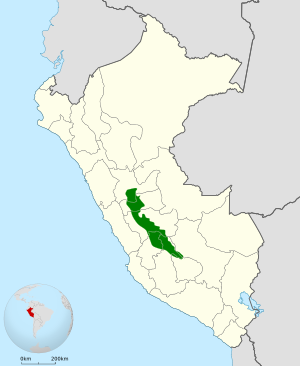Fiery-throated metaltail facts for kids
Quick facts for kids Fiery-throated metaltail |
|
|---|---|
 |
|
| A fiery-throated metaltail (below) and a rufous-webbed brilliant (above) | |
| Conservation status | |
| Scientific classification | |
| Genus: |
Metallura
|
| Species: |
eupogon
|
 |
|
The fiery-throated metaltail (Metallura eupogon) is a tiny, colorful hummingbird found only in Peru. It's known for its bright orange throat, which looks like it's glowing! This amazing bird is part of a group called "metaltails" because of their shiny, metallic-looking feathers.
Contents
About the Fiery-Throated Metaltail
The fiery-throated metaltail is a special type of hummingbird. It's considered "monotypic," which means it's the only species in its group. However, some other metaltail hummingbirds, like the violet-throated metaltail and neblina metaltail, were once thought to be the same species. Scientists study these birds to understand how they are related.
What Does it Look Like?
The fiery-throated metaltail is about 11 centimeters (4.3 inches) long. It weighs around 5 grams (0.18 ounces), which is super light! It has a straight, black beak that's not too long.
Most of the male bird's body is a yellowish olive-green color. It has shiny, bronze-like feathers. Its tail is slightly forked and looks iridescent (rainbow-like) sky blue. The underside of its tail is a glittering yellow-green. The most striking part is its throat, called a gorget, which is a bright orange.
Female fiery-throated metaltails look a lot like the males. However, their orange throat patch is smaller. Young birds look similar to the females.
Where Does it Live?
The fiery-throated metaltail lives high up in the Andes Mountains of Peru. You can find it on the eastern side of the central Andes. Its home stretches from the Huallaga River in Huánuco to the Apurímac River in Cuzco.
These hummingbirds like to live at the edges of special forests. These are called "dwarf" or "elfin" forests. They also live in "páramo" areas. A páramo is a moist, high-altitude landscape. It has lots of shrubs and small trees. Sometimes, they are also found in open clearings within the forest.
You can find these birds at elevations between 2,900 and 4,000 meters (9,500 to 13,000 feet). They are most common above 3,500 meters (11,500 feet).
How Does it Behave?
Movement and Travel
Scientists believe the fiery-throated metaltail usually stays in one place. This means it is "sedentary." However, it might move to different elevations depending on the season.
What Does it Eat?
We don't know much about what the fiery-throated metaltail eats. We also don't know exactly how it finds its food. But, we can guess it's similar to other metaltail hummingbirds.
Other metaltails drink nectar from many different kinds of flowers. They also catch small insects, like spiders or flies. They do this by flying out from a perch. Male hummingbirds often protect their favorite feeding spots from other birds.
Reproduction and Life Cycle
Not much is known about how the fiery-throated metaltail builds its nest or raises its young. The breeding season for these birds seems to be around June and July.
What Does it Sound Like?
The fiery-throated metaltail has a special call. It's often heard when one bird chases another. The call sounds like a series of 3 to 6 squeaky notes. These notes go down in pitch. After that, it makes a repeated, buzzy, jumbled sound. It's described as "trt-tsee-seee-seee-sew..trr-tsee-tsew..trr-tsee-tsew.."
Is it in Danger?
The IUCN (International Union for Conservation of Nature) has looked at the fiery-throated metaltail. They have listed it as "Least Concern." This means it's not currently in great danger of disappearing.
We don't know exactly how many of these birds there are. However, their numbers are thought to be slowly going down. Right now, they are not at high risk because they live in a wide area. They also seem to be able to adapt to different environments.
But, they could become vulnerable in the future. This is because they live in a small, specific region. One threat is the burning of páramo areas. People sometimes burn these lands to create new pastures for animals to graze. This can destroy the hummingbird's home.
See also
 In Spanish: Metallura eupogon para niños
In Spanish: Metallura eupogon para niños


